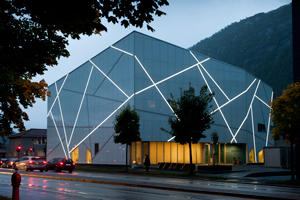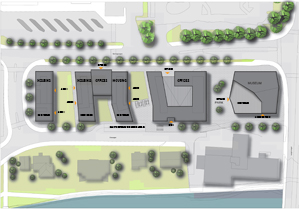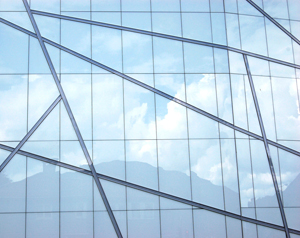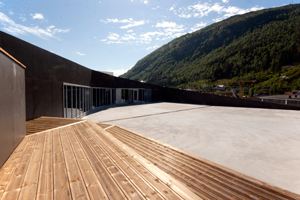 |
 |
 |
 |
 |
 |
| |
 |
|
 |
 |
 |
  |
  |
 |
 |
 |
 |
|
|
 |
|
 |
 |
 |
BUILDING |
 |
|
 |
|
 |
 |
 |
| |
 |
| 
 |
Sogn og Fjordane Kunstmuseum
Sogn & Fjordane Art Museum |
|
 |
 |
 |
 |
DESIGNER |
 |
|
|
 |
|
 |
 |
 |
| |
 |
|
 |
 |
 |
 |
DESCRIPTION |
 |
|
|
 |
|
 |
 |
 |
|
|
 |
 One will look in vain for a distinct urban center with traditional urban spaces and well-defined squares in the small Norwegian town of Førde. One will look in vain for a distinct urban center with traditional urban spaces and well-defined squares in the small Norwegian town of Førde.
Førde draws its qualities from its interaction with the surrounding mountains, which are visible everywhere, and from Jostedalsbreen, the largest glacier on the European mainland, which lies in close proximity to the town.
 It has therefore been a particular challenge to give the new Sogn & Fjordane Art Museum a significant position in the cityscape, reflecting the museum's public importance and its role in the urban context. The central location on the edge of Jøstra River along the main road Langbruvegen has resulted in an architectural approach that emphasizes the building's importance as a cultural institution which embraces entire surrounding area. It has therefore been a particular challenge to give the new Sogn & Fjordane Art Museum a significant position in the cityscape, reflecting the museum's public importance and its role in the urban context. The central location on the edge of Jøstra River along the main road Langbruvegen has resulted in an architectural approach that emphasizes the building's importance as a cultural institution which embraces entire surrounding area.
Sogn and Fjordane Art Museum draws upon the distinctive landscape for its architectural expression: the museum lies like a crystal-clear block of ice that has slid down from the surrounding mountains.
As an architectural analogy to when the glacier calves large ice blocks, the building has a crystalline form and expression. The crystalline form provides an asymmetrical plan solution, with varying displacements in the façade. This is further accentuated by a network of angled lines, reminiscent of the fracture lines in ice.
 The crystalline form provides an asymmetrical plan solution, with varying displacements in the facade. The facade is clad in white glass with a network of angled lines, reminiscent of the fracture lines in ice. This network also defines the irregular window apertures. In the evening these lines are illuminated, so that the museum lies like a sparkling block in the middle of the town’s darkness. The crystalline form provides an asymmetrical plan solution, with varying displacements in the facade. The facade is clad in white glass with a network of angled lines, reminiscent of the fracture lines in ice. This network also defines the irregular window apertures. In the evening these lines are illuminated, so that the museum lies like a sparkling block in the middle of the town’s darkness.
The facade is clad in white glass, which is crossed by a network of diagonal alignments. In the evening these lines are illuminated, creating further variation in the façade’s expression in the dark.
A triangular continuous void in the center of the building provides large surfaces suitable for exhibitions. A staircase winds its way up towards the sky light in a sculptural formation stretched in the triangular void forming an intuitive movement pattern.
 The logistic concept of the museum takes the landscape’s embrace of the city as its starting point: The visitors climb up through the museum's four floors of exhibition space, and at the top a panoramic view of the mountains can be enjoyed from a roof terrace - these mountains, that have been the catalyst and inspiration for many of the museum's artworks and collections. The logistic concept of the museum takes the landscape’s embrace of the city as its starting point: The visitors climb up through the museum's four floors of exhibition space, and at the top a panoramic view of the mountains can be enjoyed from a roof terrace - these mountains, that have been the catalyst and inspiration for many of the museum's artworks and collections.
The terrace can also function as an exhibition space or stage.
The cool surfaces of the exterior are brought into the museum's interior qua the raw, polished concrete floor, but are contrasted by warm colors and lots of wood.
The individual exhibition rooms are neutral in the choice of materials and colors, leaving the scene to the individual works of art.
The museum is part of a master plan for a site previously housing the city’s dairy. The master plan features a residential building and an office building as well as the museum.
The office building complements and highlights the museum crystalline appearance. Thus, the building - in accordance with the master plan – is executed in dark tiles representing mountain massiveness and heaviness in interaction with the museum's light and transparent character.
By situating the parking facilities below the buildings an open town square between the buildings is made possible. From here, the museum's café and lobby area is visible making the square a natural part of a spatial ensemble that ends at the museum’s rooftop terrace.
The unified construction on the site adds a new condensed urban environment to the city, which in its vocabulary draws inspiration from the great all-embracing landscape to which the city subordinates.
|
|
 |
 |
 |
 |
 |
 |
 |
LOCATION |
 |
|
|
 |
|
 |
 |
 |

|
 |

|
Continent |
|
 |
  Europe |
|
Nation |
|
 |
  Norway [Norge] |
|
Region |
|
 |
  Vestlandet |
|
County |
|
 |
  Sognefjorden (Sogn og Fjordane) |
|
Town |
|
 |
  Førde |
|
Address |
|
 |
  Museumsplassen
|
|
|
|
 |
|
Website |
|
 |
|
 |
 |
 |
 |
MAP |
 |
|
|
 |
|
 |
 |
 |
| |
 |
|
 |
 |
 |
 |
|
TYPOLOGY |
 |
|
|
 |
|
 |
 |
 |
Main |
 |
|
 |
ARCHITECTURE | Museums and buildings for exhibitions
Art museums
| |
|
|
 |
|
Additional |
 |
|
 |
ARCHITECTURE | Residential buildings
Multiple dwelling
Buildings for offices and professional practises
Offices
Buildings for recreational activities
Amphitheatres
Urban equipment and structures for public areas
Panoramic structures, belvederes
| |
 |
 |
 |
 |
CHRONOLOGY |
 |
|
|
 |
|
 |
 |
 |
Project |
 |
|
 |
| 
 |
2006
project winner of competition
|
|
Realisation |
 |
|
 |
| 
 |
2010 - 2012 |
|
 |
 |
 |
 |
AWARDS |
 |
|
|
 |
|
 |
 |
 |
| 2015 |
 |
|
 |
|
 |
 |
 |
 |
 |
 |
 |
CLIENT |
 |
|
|
 |
|
 |
 |
 |
| |
 |
| Sogn & Fjordane, Futurum AS |
|
 |
 |
 |
 |
DIMENSIONAL
DATA |
 |
|
|
 |
|
 |
 |
 |
| Surface |
 |
|
 |
|
| Floors |
 |
|
 |
| 4 floors of exhibition space |
|
 |
 |
 |
 |
LANDSCAPE DESIGN |
 |
|
|
 |
|
 |
 |
 |
| |
 |
|
 |
 |
 |
 |
STAFF |
 |
|
|
 |
|
 |
 |
 |
|
 |
|
Engineering |
 |
Hjellnes Consult
Sweco AS
Nord Vest Miljø AS |
|
Developer |
 |
|
 |
 |
 |
 |
CREDITS |
 |
|
|
 |
|
 |
 |
 |
| |
 |
Photos © Oddleiv Apneseth, Stein Sandemose Baardsen, C.F. Møller Architects
Drawings © C.F. Møller Architects
Text edit by C.F. Møller Architects
Courtesy by C.F. Møller Architects
|
|
 |
  |
 |
|
|